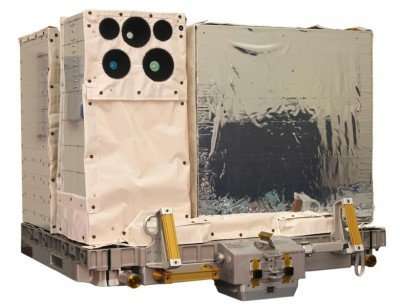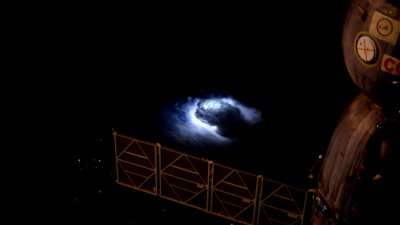Innovative camera technology to be launched into space to unravel the mysteries of lightning

A University of Bath scientist will see over 15 years of work realised today (Monday 2 April), when a scientific experiment his research has contributed towards will be sent into space for the first time.
The Atmosphere-Space Interactions Monitor (ASIM) is a state-of-the-art unique collection of optical cameras, fast light meters and X- and Gamma-ray detectors, which for the first time, will allow researchers to observe lightning in the Earth's atmosphere with unprecedented detail from space.
ASIM will observe and record the inner anatomy of lightning processes to improve an understanding of the impact of lightning on the atmosphere and infrastructure and it will contribute to more accurate climate models.
The ASIM equipment will make it possible to measure bursts of Gamma-rays – known as TGFs (Terrestrial Gamma-ray Flashes) emanating from thunderstorms. It will also observe lightning and high-altitude lightning types such as red sprites, blue jets, and gigantic jets – known as TLEs (Transient Luminous Events) - which only last a millisecond to a second in duration. The instruments will run continuously and data collected will be saved and sent to Earth for analysis.
Dr. Martin Fullekrug from the University of Bath is the only UK-based academic involved in the project and has spent over 15 years conducting research into lightning and thunderstorms which has contributed towards the development of ASIM.
The device, which weighs 314 kilograms and is roughly just over a square cubic metre in size, will be mounted on the outside of the International Space Station's (ISS) Columbus module, circulating the globe at 400km altitude. The ISS is the lowest orbiting platform in space in continuous use bringing this observation technology closest to the thunderstorm events and covers all the main thunderstorm regions, making it ideal to observe lightning processes taking place above thunderstorms between ~10-100 km.

New, unrivalled insight into lightning phenomena
The simultaneous collection of data from the combination of different cameras and sensors provide scientists with new, unrivalled insight into lightning phenomena. This data will also be combined with measurements recorded from geostationary meteorological satellites and ground based observations from all over the world.
Lightning causes many thousands of fatalities and injuries worldwide every year, it can have an impact on infrastructure assets, for example power distribution and railways, and reduce the efficiency of safety critical operations such as aviation. The ASIM space mission is the centre piece of a large-scale collaboration that brings together industry and academia to derive the maximum benefit for society from the knowledge gained.
ASIM is due to be launched on the SpaceX Falcon-9/Dragon rocket from Cape Canaveral in Florida, USA at 9.30pm BST and will observe lightning from space over the next 2 years.
The ASIM instrument was built by a number of international partners including Technical University of Denmark (DTU); Danish defence and aerospace manufacturer, TERMA; University of Valencia, Spain; University of Bergen, Norway; Space Research Center, Poland; and Italian aerospace company, OHB-Italia.
The realisation of over 15 years of research
Reader in the University of Bath's Department of Electronic & Electrical Engineering, Dr. Martin Fullekrug, said: "I have been researching and investigating space and lightning events for over 15 years and the launch of ASIM feels like the pinnacle of my journey into understanding this phenomenon.
"This is the first time such a detailed and technologically-advanced measurement device will be flown into space to observe lightning and will hopefully provide us with new knowledge about how lightning is initiated and how the properties of lightning can affect our daily lives in so many different ways.
Dr. Graham Turnock, Chief Executive of the UK Space Agency said: "This experiment will give scientists all over the world the opportunity to study the effects of powerful lightning storms from the unique vantage point of the International Space Station. It's another exciting moment for international space collaboration and commercial spaceflight, which the UK Space Agency supports through the Government's Industrial Strategy."
Provided by University of Bath


















